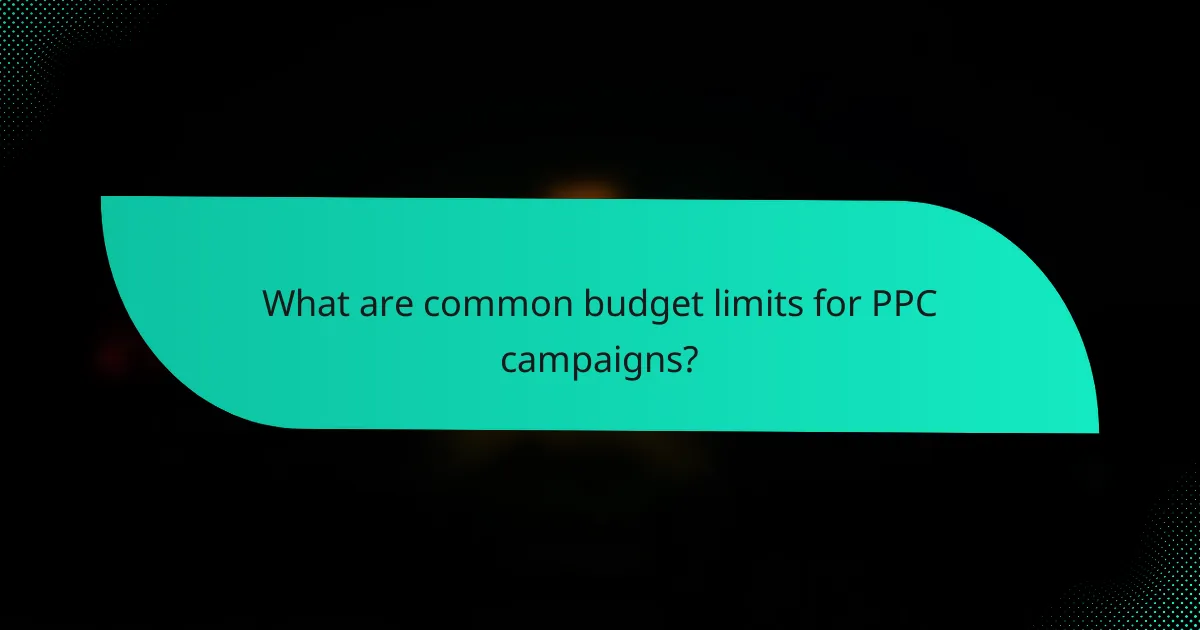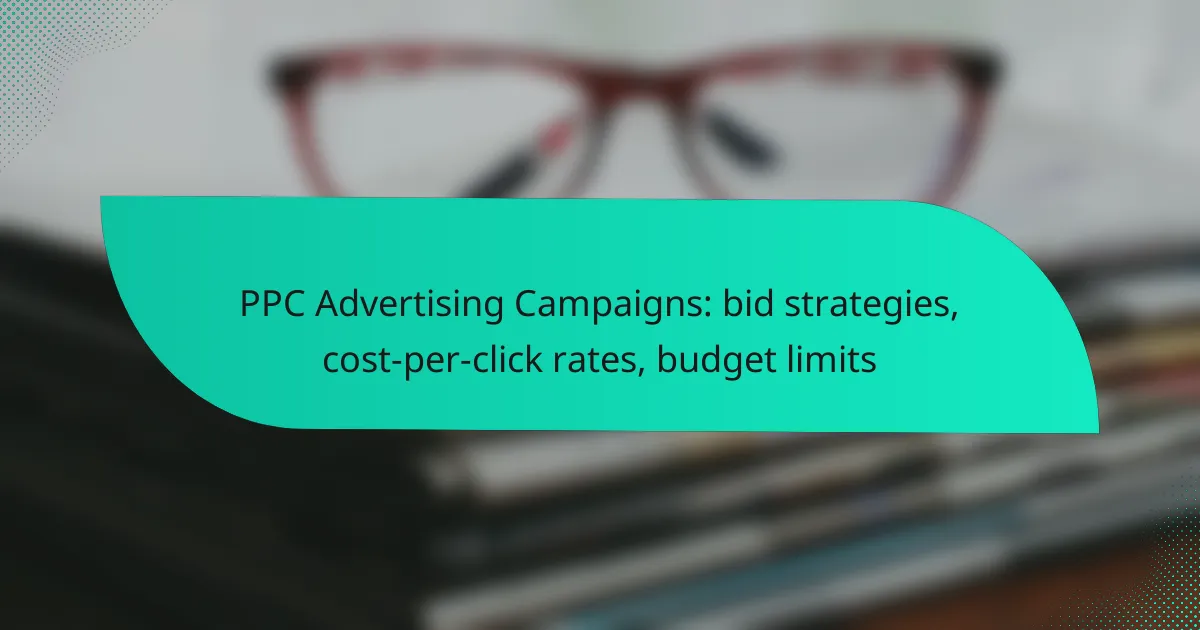PPC advertising campaigns require careful consideration of bid strategies, cost-per-click rates, and budget limits to optimize performance and return on investment. By selecting the right bid strategy that aligns with campaign goals, advertisers can effectively manage their spending. Additionally, understanding the variability of CPC rates and setting appropriate budget limits are crucial for successful campaign execution.

What are effective PPC bid strategies in the UK?
Effective PPC bid strategies in the UK include various approaches that help advertisers manage their spending while maximizing returns. Each strategy has its own strengths, making it essential to choose one that aligns with your campaign goals and budget constraints.
Manual CPC bidding
Manual CPC (Cost Per Click) bidding allows advertisers to set their own maximum bid for each click on their ads. This strategy provides full control over how much you are willing to pay, making it suitable for campaigns with specific budget limits.
However, it requires ongoing monitoring and adjustments to ensure optimal performance. Advertisers should regularly review their click-through rates (CTR) and conversion rates to fine-tune their bids effectively.
Enhanced CPC bidding
Enhanced CPC bidding is an automated bidding strategy that adjusts your manual bids based on the likelihood of conversion. This means that if a click is deemed more likely to result in a sale, the system will increase your bid, helping to maximize conversions without exceeding your budget.
This strategy is particularly useful for advertisers who want to maintain some control while leveraging automation. It’s important to track performance metrics to ensure that the increased bids are yielding positive results.
Target CPA bidding
Target CPA (Cost Per Acquisition) bidding focuses on getting as many conversions as possible at a specified cost per acquisition. Advertisers set a target CPA, and the system automatically adjusts bids to achieve this goal.
This strategy is beneficial for campaigns with clear conversion goals, such as lead generation or sales. However, it requires sufficient historical data to set an effective target CPA, so new campaigns may need to start with a different strategy before transitioning.
Target ROAS bidding
Target ROAS (Return On Ad Spend) bidding aims to maximize revenue based on a specified return on ad spend. Advertisers set a target ROAS, and the bidding system adjusts bids to achieve this return.
This strategy is ideal for e-commerce businesses that want to focus on revenue rather than just conversions. It’s crucial to have accurate tracking in place to measure revenue and ensure that the target ROAS is realistic based on historical performance.
Maximize conversions bidding
Maximize conversions bidding is an automated strategy that aims to get the most conversions possible within your budget. The system analyzes various factors to determine the optimal bid for each auction, making it a hands-off approach for advertisers.
This strategy works well for campaigns with a clear conversion goal and sufficient budget. However, it may lead to higher costs per click if not monitored closely, so regular performance reviews are essential to avoid overspending.

How do cost-per-click rates vary in the UK?
Cost-per-click (CPC) rates in the UK can fluctuate significantly based on various factors, including industry, competition, and regional differences. Advertisers should be aware of these variations to effectively plan their PPC campaigns and budget accordingly.
Average CPC rates by industry
Average CPC rates in the UK differ across industries, reflecting the competitiveness of each sector. For instance, industries such as finance and insurance often see higher CPC rates, typically ranging from £1 to £3, while sectors like retail may have lower rates, often between £0.50 and £1.50.
Understanding these averages helps advertisers set realistic budget expectations and optimize their bidding strategies. It’s advisable to research specific industry benchmarks to tailor campaigns effectively.
Factors affecting CPC rates
Several factors influence CPC rates, including keyword competition, ad quality, and targeting options. Highly competitive keywords generally lead to increased CPC rates due to higher demand among advertisers.
Additionally, the quality score of ads, which considers relevance and performance, can lower CPC rates. Advertisers should focus on improving ad quality to achieve better positioning at lower costs.
Regional CPC variations in the UK
Regional differences in the UK can also impact CPC rates, with urban areas typically experiencing higher rates compared to rural regions. For example, London may see CPC rates that are 20-30% higher than those in smaller cities.
Advertisers should consider these regional variations when targeting specific demographics or locations, as adjusting bids based on geography can lead to more effective ad spend and improved campaign performance.

What are common budget limits for PPC campaigns?
Common budget limits for PPC campaigns vary widely based on industry, goals, and competition. Typically, businesses set daily budgets ranging from a few dollars to several thousand, depending on their overall marketing strategy and financial capacity.
Daily budget recommendations
For daily budgets, a common recommendation is to start with a minimum of $10 to $50 per day for small businesses. Larger companies may allocate $100 to $500 or more daily, especially in competitive markets. It’s crucial to monitor performance and adjust the budget based on the return on investment (ROI).
Consider using a percentage of your overall marketing budget for PPC. A common approach is to allocate 20-30% of your total marketing spend to pay-per-click advertising, adjusting as needed based on campaign performance.
Monthly budget planning
When planning monthly budgets, consider your daily budget multiplied by the number of days in the month. For example, a daily budget of $50 would result in a monthly budget of approximately $1,500. This approach helps ensure consistent spending and visibility throughout the month.
It’s also beneficial to account for seasonal fluctuations in demand. For instance, if your business experiences higher sales during certain months, consider increasing your monthly budget during those peak times to maximize visibility and conversions.
Budget allocation strategies
Effective budget allocation strategies involve distributing your budget across various campaigns and ad groups based on performance. Prioritize campaigns that yield the highest ROI while ensuring that you test new campaigns with a smaller portion of your budget.
Another strategy is to allocate budgets based on keyword performance. Invest more in high-performing keywords while reducing spend on underperforming ones. Regularly review and adjust your budget allocation to reflect changing market conditions and campaign results.

What criteria should be considered for PPC campaign success?
Successful PPC campaigns hinge on several key criteria, including effective bid strategies, cost-per-click (CPC) rates, and budget limits. Evaluating these factors helps ensure that campaigns achieve desired outcomes while maintaining cost efficiency.
Key performance indicators (KPIs)
Key performance indicators (KPIs) are essential metrics that gauge the effectiveness of a PPC campaign. Common KPIs include click-through rate (CTR), conversion rate, and return on ad spend (ROAS). Tracking these metrics allows advertisers to assess performance and make data-driven adjustments.
For instance, a CTR of 2-5% is often considered good, while a conversion rate of 2-10% can indicate a successful campaign. Regularly reviewing these KPIs helps identify trends and areas for improvement, ensuring that the campaign remains aligned with business goals.
Conversion tracking methods
Conversion tracking methods are crucial for understanding how well a PPC campaign translates clicks into desired actions, such as purchases or sign-ups. Common methods include using tracking pixels, Google Analytics goals, and unique URLs. Implementing these tools allows advertisers to accurately measure the effectiveness of their ads.
For example, setting up Google Ads conversion tracking can help identify which keywords or ads drive the most conversions. This data enables advertisers to optimize their campaigns by reallocating budgets to high-performing areas and refining underperforming ads. Regularly auditing conversion tracking setups ensures accurate data collection and reporting.

What advanced techniques enhance PPC performance?
Advanced techniques such as remarketing strategies can significantly boost the performance of PPC advertising campaigns. These methods focus on re-engaging potential customers who have previously interacted with your brand, thus increasing conversion rates and optimizing ad spend.
Remarketing strategies
Remarketing strategies involve targeting users who have already visited your website or engaged with your ads. By displaying tailored ads to these individuals as they browse other sites, you can remind them of your offerings and encourage them to return and complete a purchase.
To implement effective remarketing, consider segmenting your audience based on their previous interactions. For instance, you might create different ads for users who abandoned their shopping carts versus those who simply browsed. This targeted approach can lead to higher engagement and conversion rates.
When setting up remarketing campaigns, ensure you comply with privacy regulations, such as GDPR in Europe. Always provide users with clear options to opt out of remarketing lists. Additionally, monitor the performance of your ads regularly to optimize your strategies and budgets effectively.
